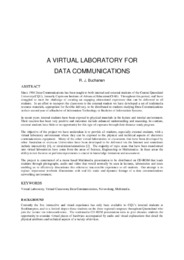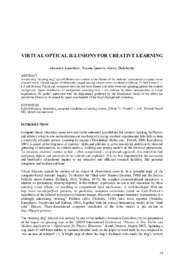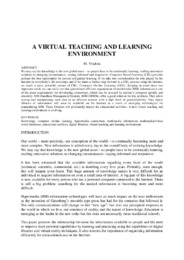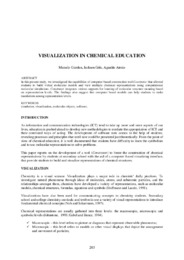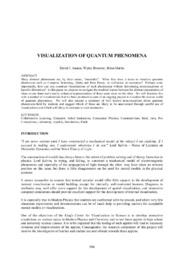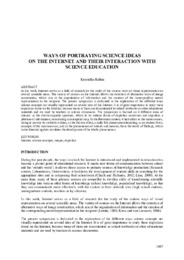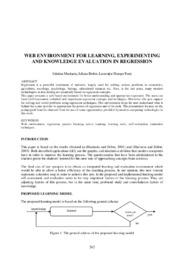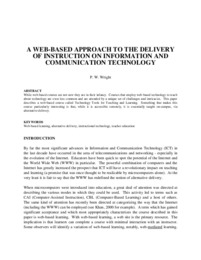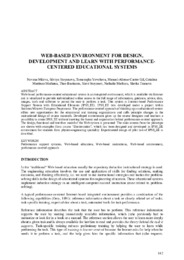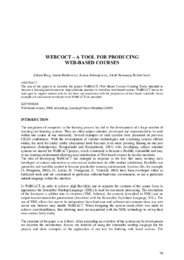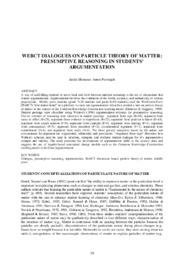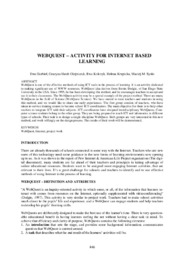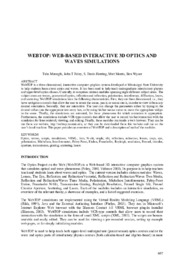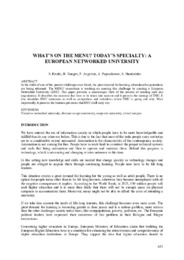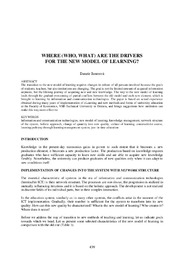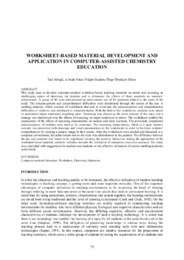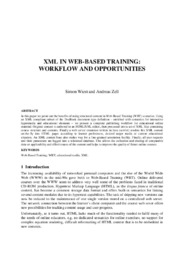Browsing Computer Based Learning in Science (CBLIS) by Title
Now showing items 317-336 of 337
-
A virtual laboratory for data communications
(Pedagogical Faculty of University of Ostrava, 2001)University(CQU), formerly Capricorn Institute of Advanced Education(CIAE). Throughout this period, staff have struggled to meet the challenge of creating an engaging educational experience that can be delivered to all students. ... -
Virtual optical illusions for creative learning
(Department of Educational Sciences, University of Cyprus, 2003)An amazing “rotating ring” optical illusion was studied in the frames of the students’ educational computer-based research work. Virtual images of differently shaped moving objects were simulated in QBasic 71, MS Visual ... -
A virtual teaching and learning Environment
(Pedagogical Faculty of University of Ostrava, 2001)We may say the knowledge is the new global asset – so people have to be continually learning, crafting innovative solutions to changing circumstances, staying informed and responsive. Computer Based Learning (CBL) ... -
Visualization in chemical education
(University of Zilina, 2005)In this present study, we investigated the capabilities of computer-based construction tool Construtor that allowed students to build virtual molecular models and view multiple chemical representations using computational ... -
Visualization of quantum phenomena
(University of Cyprus, 2007)Many abstract phenomena are, by their nature, "unseeable". What then does it mean to visualize quantum phenomena such as Compton Scattering, Alpha and Beta Decay, or collisional de-excitation? Perhaps more importantly, how ... -
Volume: a computer microworld For the learning of the concept of volume
(University of Zilina, 2005)This paper presents the design and basic features of a computer microworld for learning the concept of volume, for use by both primary and secondary level education students. The design of this microworld is the result of ... -
Ways of portraying science ideas on the internet and their interaction with science education
(Department of Educational Sciences, University of Cyprus, 2003)In this work, Internet serves as a field of research for the study of the various ways of visual representation on several scientific areas. The variety of sources on the Internet allows the detection of alternative ways ... -
A web based approach to teaching the subject “renewable energy sources” in technical Vocational educational schools in greece Using the elearn web platform
(University of Cyprus, 2007)During the last years, computers have found their way into Greek secondary education. At the same time, environmental education has also received special attention in both primary and secondary education, due in part to ... -
Web environment for learning, experimenting and knowledge evaluation in regression
(University of Zilina, 2005)Regression is a powerful instrument of statistics, largely used for solving various problems in economics, agriculture, sociology, psychology, biology, educational sciences etc. Also, in the last years, many modern ... -
A web-based approach to the delivery of instruction on information and Communication technology
(Pedagogical Faculty of University of Ostrava, 2001)While web-based courses are not new they are in their infancy. Courses that employ web-based technology to teach about technology are even less common and are attended by a unique set of challenges and intricacies. This ... -
Web-based environment for design, development and learn with performance-centered Educational systems
(Department of Educational Sciences, University of Cyprus, 2003)Web-based performance-centred educational system is an integrated environment, which is available via Internet and is structured to provide individualized online access to the full range of information, guidance, advice, ... -
Webcoct – a tool for producing web-based courses
(Department of Educational Sciences, University of Cyprus, 2003)The aim of the paper is to describe the project WeBCoCT (Web Based Courses Creating Tools) intended to become a learning environment to help academic teachers to introduce web-based courses. WeBCoCT has as its main goal ... -
WebCT dialogues on particle theory of matter: presumptive reasoning in students’ argumentation
(Department of Educational Sciences, University of Cyprus, 2003)A way of scaffolding students to move back and forth between multiple meanings is the use of discussions that feature argumentation. Argumentation involves the evaluation of the worth, accuracy, and authenticity of various ... -
Webquest – activity for internet based learning
(University of Zilina, 2005)WebQuest is one of the effective methods of using ICT tools in the process of learning. It is an activity dedicated to making significant use of WWW resources. WebQuest idea derives from Bernie Dodgie, of San Diego State ... -
Webtop: web-based interactive 3d optics and Waves simulations
(Department of Educational Sciences, University of Cyprus, 2003)WebTOP is a three-dimensional, interactive computer graphics system developed at Mississippi State University to help students learn about optics and waves. It has been used to help teach undergraduate introductory physics ... -
What’s on the menu? Today’s specialty: a European networked university
(Department of Educational Sciences, University of Cyprus, 2003)In the midst of one of the greatest challenges ever faced, the great demand for learning, educational organizations are being reformed. The MENU consortium is working on meeting this challenge by creating a European Networked ... -
When computer use is associated with Negative science achievement
(Department of Educational Sciences, University of Cyprus, 2003)One surprising result of the Third International Mathematics and Science Study (TIMSS) is that computer use in the classroom was negatively associated with high student achievement in Cyprus, Hong Kong and the USA. The ... -
Where (who, what) are the drivers for the new model of learning?
(University of Zilina, 2005)The transition to the new model of learning requires changes in culture of all persons involved because the goals of students, teachers, but also institutions are changing. The goal is not the limited amount of acquired ... -
Worksheet-based material development and Application in computer-assisted chemistry Education
(University of Cyprus, 2007)This study aims to develop computer-assisted worksheet-based teaching materials on atoms and screening as challenging topics of chemistry for students and to determine the effects of these materials on students’ achievement. ... -
XML in web-based training: Workflow and opportunities
(Pedagogical Faculty of University of Ostrava, 2001)In this paper we point out the benefits of using structured content in Web-Based Training (WBT) scenarios. Using an XML compliant subset of the DocBook document type definition – enriched with semantics for interactive hypermedia ...
